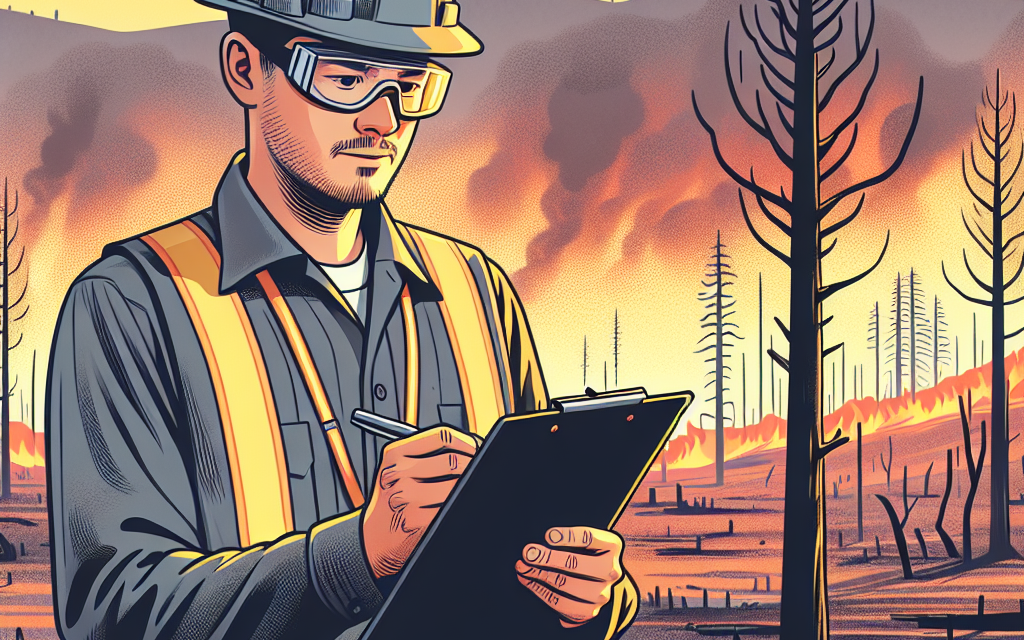“Mercury General: Assessing the Impact of California Wildfires for a Safer Tomorrow.”
Introduction
Mercury General, a prominent auto and home insurance provider, has undertaken a comprehensive evaluation of the effects of California wildfires on its operations and policyholders. With the increasing frequency and intensity of wildfires in the region, the company aims to assess the impact on claims, underwriting practices, and overall risk management strategies. This evaluation is crucial for understanding the long-term implications of wildfire events on both the insurance industry and the communities affected, as well as for developing proactive measures to enhance resilience and support for policyholders in the face of future disasters.
Mercury Levels in Air Quality Post-Wildfires
In the aftermath of California’s devastating wildfires, the evaluation of air quality has become a critical concern, particularly regarding the levels of mercury present in the atmosphere. Wildfires are known to release a variety of pollutants, and understanding the specific impact of these events on mercury levels is essential for public health and environmental safety. Mercury, a toxic heavy metal, can have severe implications for both human health and ecological systems, making its monitoring a priority in the wake of such disasters.
Research indicates that wildfires can mobilize mercury that has been deposited in the environment over time. This mobilization occurs through the combustion of organic matter, which can release previously stored mercury into the air. As the flames consume vegetation and soil, they can vaporize mercury, allowing it to enter the atmosphere. Consequently, the air quality in areas affected by wildfires can deteriorate significantly, leading to increased exposure for nearby populations. This phenomenon raises concerns about the potential health risks associated with inhaling mercury-laden particulates.
Moreover, the effects of mercury on air quality are not limited to immediate post-wildfire conditions. The atmospheric mercury released during wildfires can undergo various transformations, including deposition back to the earth’s surface through precipitation. This process can lead to the contamination of water bodies and soil, further exacerbating the environmental impact of wildfires. As mercury settles into aquatic ecosystems, it can bioaccumulate in fish and other organisms, posing long-term risks to wildlife and humans who consume contaminated resources.
In light of these concerns, Mercury General has undertaken a comprehensive evaluation of air quality in regions affected by California wildfires. This evaluation involves the collection and analysis of air samples to determine the concentration of mercury and other harmful pollutants. By employing advanced monitoring techniques, researchers can gain insights into the extent of mercury contamination and its potential health implications for local communities. The findings from these assessments are crucial for informing public health responses and guiding policy decisions aimed at mitigating the risks associated with wildfire smoke.
Furthermore, it is essential to consider the broader implications of mercury exposure in the context of wildfire management and environmental policy. As climate change continues to increase the frequency and intensity of wildfires, understanding the relationship between these events and mercury levels becomes increasingly urgent. Policymakers must prioritize research and monitoring efforts to develop effective strategies for managing air quality during and after wildfire events. This includes implementing measures to reduce emissions from wildfires and enhancing public awareness about the potential health risks associated with mercury exposure.
In conclusion, the evaluation of mercury levels in air quality following California wildfires is a vital area of research that has significant implications for public health and environmental management. As wildfires continue to pose a threat to air quality, understanding the dynamics of mercury release and its subsequent effects is essential for protecting communities and ecosystems. By prioritizing comprehensive monitoring and research efforts, stakeholders can better prepare for the challenges posed by wildfires and work towards minimizing their impact on air quality and public health. Ultimately, a proactive approach to understanding and addressing mercury levels in the aftermath of wildfires will contribute to safer, healthier environments for all.
Impact of Wildfires on Mercury Contamination in Soil
The impact of wildfires on mercury contamination in soil is a critical concern, particularly in regions like California, where wildfires have become increasingly frequent and intense. As these fires rage through vast landscapes, they not only devastate ecosystems and communities but also have far-reaching implications for soil quality and safety. One of the lesser-known consequences of wildfires is their potential to mobilize mercury, a toxic heavy metal that can have detrimental effects on both human health and the environment.
Mercury is naturally present in the environment, often originating from geological sources, but human activities, such as mining and industrial processes, have significantly increased its levels. When wildfires occur, the intense heat can vaporize mercury that is bound to soil particles or organic matter, releasing it into the atmosphere. This process can lead to the deposition of mercury in areas far removed from the original source, thereby contaminating previously unaffected soils. As a result, the cycle of mercury contamination can be exacerbated, posing risks to both terrestrial and aquatic ecosystems.
Moreover, the aftermath of wildfires often leaves behind a landscape that is altered in terms of vegetation and soil composition. The loss of plant cover can lead to increased erosion, which may further disturb mercury-laden soils. As rainwater washes over these areas, it can transport mercury into nearby water bodies, where it can bioaccumulate in fish and other aquatic organisms. This bioaccumulation poses a significant risk to wildlife and humans who rely on these resources for food. Consequently, the implications of mercury contamination extend beyond the immediate aftermath of a wildfire, affecting food chains and public health for years to come.
In addition to the physical movement of mercury, wildfires can also change the chemical dynamics of soil. The combustion of organic matter alters the pH and redox conditions of the soil, which can influence the solubility and mobility of mercury. Under certain conditions, mercury can be converted into more toxic forms, such as methylmercury, which is readily absorbed by living organisms. This transformation is particularly concerning because methylmercury is known to have severe neurotoxic effects, especially in developing fetuses and young children. Therefore, understanding the chemical interactions that occur during and after wildfires is essential for assessing the long-term risks associated with mercury contamination.
Furthermore, the evaluation of mercury contamination in soil following wildfires is crucial for informing remediation efforts. Identifying areas with elevated mercury levels allows for targeted interventions that can mitigate the risks to human health and the environment. For instance, soil amendments or phytoremediation techniques may be employed to stabilize mercury and reduce its bioavailability. Additionally, monitoring programs can be established to track changes in mercury levels over time, providing valuable data for researchers and policymakers.
In conclusion, the impact of wildfires on mercury contamination in soil is a multifaceted issue that requires careful consideration. As California continues to face the challenges posed by wildfires, understanding the dynamics of mercury release and its subsequent effects on soil and water quality becomes increasingly important. By evaluating these impacts, stakeholders can develop effective strategies to protect public health and preserve the integrity of ecosystems in the wake of such devastating events. The interplay between wildfires and mercury contamination underscores the need for ongoing research and proactive measures to address this pressing environmental concern.
Health Risks Associated with Mercury Exposure After Wildfires
The recent wildfires in California have raised significant concerns regarding public health, particularly in relation to mercury exposure. As these devastating fires sweep through vast landscapes, they not only destroy homes and ecosystems but also release a variety of toxic substances into the air, including mercury. This heavy metal, which can be found in various forms in the environment, poses serious health risks, especially when released into the atmosphere during such catastrophic events. Understanding the implications of mercury exposure following wildfires is crucial for safeguarding public health and informing recovery efforts.
When wildfires occur, they can ignite materials that contain mercury, such as certain types of electrical equipment, batteries, and even some household items. As these materials burn, mercury can vaporize and enter the atmosphere, where it can be inhaled by individuals in the vicinity. This inhalation poses immediate health risks, as mercury is a neurotoxin that can affect the central nervous system. Symptoms of mercury exposure may include tremors, memory problems, and cognitive deficits, which can be particularly concerning for vulnerable populations such as children and pregnant women.
Moreover, the health risks associated with mercury exposure extend beyond immediate inhalation. Once mercury is released into the environment, it can settle on soil and water bodies, leading to further contamination. This process can result in the bioaccumulation of mercury in fish and other wildlife, which can then enter the food chain. Consequently, individuals who consume contaminated fish may face long-term health risks, including developmental issues in children and increased risk of cardiovascular diseases in adults. The implications of this bioaccumulation are particularly alarming for communities that rely on fishing as a primary source of sustenance.
In addition to the direct health risks posed by mercury exposure, the psychological impact of wildfires cannot be overlooked. The stress and anxiety associated with losing homes and livelihoods can exacerbate existing health conditions and lead to increased vulnerability to the effects of toxic exposures. This interplay between mental health and physical health highlights the need for comprehensive recovery strategies that address both the environmental and psychological aftermath of wildfires.
Furthermore, it is essential to consider the role of public health agencies and environmental organizations in monitoring and mitigating the effects of mercury exposure following wildfires. These entities must work collaboratively to assess air and water quality in affected areas, providing timely information to residents about potential risks. Public education campaigns can also play a vital role in informing communities about safe practices, such as avoiding consumption of locally caught fish until testing confirms safety.
In conclusion, the health risks associated with mercury exposure after wildfires are multifaceted and require a coordinated response from various stakeholders. As California continues to grapple with the consequences of wildfires, it is imperative to prioritize public health initiatives that address both immediate and long-term risks associated with mercury. By fostering awareness and implementing effective monitoring strategies, communities can better protect themselves from the hidden dangers that may linger long after the flames have been extinguished. Ultimately, a proactive approach to understanding and mitigating these risks will be essential in ensuring the health and well-being of those affected by such environmental disasters.
Mercury Emissions from Wildfires: A Comprehensive Analysis
The increasing frequency and intensity of wildfires in California have raised significant concerns regarding their environmental impact, particularly in relation to mercury emissions. As wildfires consume vast areas of vegetation, they release a variety of pollutants into the atmosphere, including particulate matter, carbon dioxide, and various heavy metals. Among these, mercury—a toxic element that poses serious health risks—has garnered particular attention. Understanding the dynamics of mercury emissions from wildfires is crucial for assessing their broader ecological and public health implications.
Mercury is a naturally occurring element found in the environment, primarily in the form of elemental mercury, inorganic mercury, and organic mercury compounds. It can enter the atmosphere through various natural and anthropogenic processes, including volcanic eruptions, industrial activities, and, notably, wildfires. When vegetation burns, mercury stored in plant tissues is released into the air, where it can be transported over long distances. This phenomenon is particularly concerning in California, where the combination of dry conditions, high temperatures, and strong winds creates an ideal environment for wildfires.
Research indicates that the amount of mercury emitted during a wildfire can vary significantly based on several factors, including the type of vegetation burned, the intensity of the fire, and the duration of the burning event. For instance, studies have shown that forests and grasslands can release different quantities of mercury due to their distinct biomass compositions. Additionally, hotter and more intense fires tend to vaporize more mercury, leading to higher emissions. This variability complicates efforts to quantify the total mercury released during wildfire events and underscores the need for comprehensive monitoring and analysis.
Moreover, the implications of mercury emissions extend beyond immediate air quality concerns. Once released into the atmosphere, mercury can undergo a series of transformations, eventually depositing into water bodies and terrestrial ecosystems. This deposition can lead to the bioaccumulation of mercury in fish and other wildlife, posing risks to both ecological health and human populations that rely on these resources for food. Consequently, communities near wildfire-prone areas may face increased exposure to mercury through contaminated fish and water supplies, raising public health concerns that warrant attention.
In light of these challenges, it is essential for organizations like Mercury General to evaluate the effects of wildfires on mercury emissions systematically. By conducting comprehensive analyses, researchers can better understand the relationship between wildfire dynamics and mercury release, ultimately informing policy decisions and public health strategies. Such evaluations can also aid in the development of predictive models that assess the potential impacts of future wildfires on mercury emissions, allowing for more effective risk management and mitigation efforts.
Furthermore, collaboration among scientists, policymakers, and public health officials is vital in addressing the multifaceted issues associated with mercury emissions from wildfires. By sharing data and insights, stakeholders can develop targeted interventions aimed at reducing mercury exposure in vulnerable communities. This collaborative approach not only enhances our understanding of the environmental impacts of wildfires but also fosters resilience in the face of an increasingly volatile climate.
In conclusion, the evaluation of mercury emissions from California wildfires is a critical area of research that has far-reaching implications for environmental health and public safety. As wildfires continue to pose significant threats to ecosystems and communities, a comprehensive understanding of their effects on mercury emissions will be essential for developing effective strategies to mitigate these risks and protect public health.
Long-Term Environmental Effects of Mercury from California Wildfires
The long-term environmental effects of mercury released during California wildfires are a growing concern for scientists, policymakers, and communities alike. As wildfires become increasingly frequent and intense due to climate change, understanding the implications of mercury emissions is crucial for environmental health and safety. Mercury, a toxic heavy metal, can be released into the atmosphere during wildfires when organic matter, including vegetation and soil, is burned. This process can lead to the volatilization of mercury that has accumulated in the environment over time, particularly in areas with a history of industrial activity or mining.
Once mercury is released into the atmosphere, it can travel long distances before settling back to the ground through precipitation or atmospheric deposition. This phenomenon raises significant concerns about the contamination of ecosystems far removed from the original fire site. For instance, mercury can accumulate in water bodies, where it is converted into methylmercury, a highly toxic form that poses serious risks to aquatic life and, subsequently, to humans who consume contaminated fish. The bioaccumulation of methylmercury in the food chain can lead to elevated mercury levels in top predators, including birds and mammals, which can have detrimental effects on their health and reproductive success.
Moreover, the impact of mercury from wildfires is not limited to aquatic ecosystems. Terrestrial environments can also suffer from mercury deposition, affecting soil quality and plant health. As mercury settles into the soil, it can be taken up by plants, leading to further bioaccumulation in herbivores and, ultimately, in carnivores. This cycle of contamination can disrupt entire food webs, leading to declines in biodiversity and altering ecosystem dynamics. The long-term presence of mercury in these environments can hinder recovery efforts following wildfires, as the toxic metal can persist in the soil and water for years, if not decades.
In addition to ecological consequences, the release of mercury during wildfires poses significant public health risks. Communities located near wildfire-prone areas may be exposed to elevated levels of mercury through air, water, and food sources. Vulnerable populations, including children and pregnant women, are particularly at risk due to the neurotoxic effects of mercury. Long-term exposure can lead to developmental issues, cognitive impairments, and other serious health problems. Consequently, understanding the pathways of mercury exposure and implementing effective monitoring and mitigation strategies is essential for protecting public health.
Furthermore, the interplay between climate change and wildfire frequency exacerbates the mercury issue. As temperatures rise and drought conditions become more prevalent, the likelihood of wildfires increases, leading to more frequent releases of mercury into the environment. This creates a feedback loop where climate change drives wildfires, which in turn releases more mercury, further impacting ecosystems and human health. Addressing this complex challenge requires a multifaceted approach that includes improved wildfire management practices, enhanced monitoring of mercury levels in affected areas, and public education on the risks associated with mercury exposure.
In conclusion, the long-term environmental effects of mercury released during California wildfires are profound and multifaceted. The implications extend beyond immediate ecological damage, affecting water quality, food safety, and public health. As the frequency of wildfires continues to rise, it is imperative that stakeholders prioritize research and action to mitigate the impacts of mercury and protect both the environment and human health for future generations.
Strategies for Monitoring Mercury in Wildfire-Affected Areas
In the wake of California’s devastating wildfires, the need for effective monitoring of environmental contaminants has become increasingly critical. Among these contaminants, mercury poses significant risks to both ecosystems and human health. As Mercury General evaluates the effects of these wildfires, it is essential to explore strategies for monitoring mercury levels in affected areas. This process begins with understanding the pathways through which mercury can be released into the environment during and after a wildfire event.
Wildfires can disturb the soil and vegetation, leading to the release of mercury that has been previously stored in organic matter. When trees and plants burn, the combustion process can vaporize mercury, allowing it to enter the atmosphere. Additionally, ash and debris can carry mercury particles, which may settle in nearby water bodies or soil, further complicating the monitoring process. Therefore, it is crucial to establish a comprehensive monitoring framework that addresses these various pathways.
One effective strategy for monitoring mercury in wildfire-affected areas involves the use of remote sensing technology. This approach allows researchers to assess large areas quickly and efficiently, identifying hotspots where mercury contamination may be more pronounced. By employing satellite imagery and aerial surveys, scientists can detect changes in land cover and vegetation health, which may indicate areas of increased mercury release. This method not only saves time but also provides a broader perspective on the extent of contamination across the landscape.
In addition to remote sensing, ground-based sampling remains a vital component of mercury monitoring. Collecting soil, water, and vegetation samples from various locations within wildfire-affected regions enables researchers to obtain accurate measurements of mercury levels. This data can then be analyzed to determine the concentration of mercury in different media, providing insights into how the wildfires have altered the distribution of this toxic element. Furthermore, establishing a network of monitoring sites can facilitate long-term studies, allowing scientists to track changes in mercury levels over time and assess the effectiveness of remediation efforts.
Collaboration with local agencies and communities is another essential strategy for effective monitoring. Engaging with stakeholders, including environmental organizations, public health officials, and local residents, can enhance data collection efforts and ensure that monitoring activities are aligned with community needs. By fostering partnerships, Mercury General can leverage local knowledge and resources, ultimately leading to more comprehensive assessments of mercury contamination in wildfire-affected areas.
Moreover, public education plays a crucial role in the monitoring process. Informing communities about the potential risks associated with mercury exposure and the importance of monitoring can empower individuals to take proactive measures. Workshops, informational pamphlets, and community meetings can serve as platforms for disseminating knowledge and encouraging community involvement in monitoring efforts. By raising awareness, Mercury General can help foster a culture of environmental stewardship, where residents actively participate in safeguarding their health and the health of their environment.
In conclusion, the evaluation of mercury levels in wildfire-affected areas requires a multifaceted approach that combines advanced technology, ground-based sampling, community engagement, and public education. By implementing these strategies, Mercury General can effectively monitor the impacts of California wildfires on mercury contamination, ultimately contributing to a better understanding of the long-term effects on both ecosystems and human health. As the frequency and intensity of wildfires continue to rise, these monitoring efforts will be essential in mitigating the risks associated with mercury exposure and ensuring a healthier future for all.
Community Awareness: Understanding Mercury Risks After Wildfires
In the aftermath of California wildfires, the focus often shifts to immediate concerns such as property damage, air quality, and the displacement of residents. However, an equally important aspect that requires attention is the potential risk of mercury contamination in affected communities. Mercury, a toxic heavy metal, can pose significant health risks, particularly in areas where wildfires have burned through industrial sites, landfills, or other locations where mercury may be present. Understanding these risks is crucial for community awareness and safety.
When wildfires occur, they can release various pollutants into the atmosphere, including particulate matter and toxic metals. Mercury, which can be found in batteries, fluorescent lights, and certain industrial products, may be released into the air or deposited into the soil and water systems during such events. As the flames consume materials, they can vaporize mercury, allowing it to travel long distances before settling back to the ground. This process can lead to contamination of local ecosystems, affecting both wildlife and human populations.
Moreover, the risk of mercury exposure is not limited to the immediate aftermath of a wildfire. As communities begin the recovery process, the potential for mercury to enter the food chain becomes a pressing concern. Fish and other aquatic organisms can absorb mercury from contaminated water, leading to bioaccumulation. Consequently, when residents consume fish from local water bodies, they may unknowingly expose themselves to elevated levels of mercury. This is particularly alarming for vulnerable populations, including pregnant women and young children, who are more susceptible to the neurotoxic effects of mercury.
In light of these risks, it is essential for communities to engage in proactive measures to assess and mitigate mercury exposure following wildfires. Local health departments and environmental agencies play a critical role in monitoring air and water quality, as well as conducting soil tests in areas that have experienced significant fire damage. By identifying contaminated sites, authorities can implement cleanup efforts and provide guidance to residents on safe practices, such as avoiding the consumption of fish from affected waters until testing confirms their safety.
Furthermore, community awareness campaigns can help educate residents about the potential risks associated with mercury exposure. Informational sessions, workshops, and distribution of educational materials can empower individuals to take informed actions. For instance, residents should be encouraged to report any unusual fish kills or changes in wildlife behavior, as these may be indicators of mercury contamination. Additionally, promoting safe disposal practices for household items that may contain mercury can further reduce the risk of exposure.
In conclusion, the evaluation of mercury risks following California wildfires is a critical component of community health and safety. By understanding the pathways through which mercury can enter the environment and affect human health, communities can take informed steps to protect themselves. Collaborative efforts between local authorities, health organizations, and residents are essential in raising awareness and implementing effective strategies to mitigate these risks. As California continues to face the challenges posed by wildfires, prioritizing community education and environmental monitoring will be vital in safeguarding public health and ensuring a resilient recovery.
Q&A
1. **Question:** What is the primary focus of Mercury General’s evaluation regarding California wildfires?
**Answer:** The primary focus is to assess the impact of wildfires on insurance claims and overall financial performance.
2. **Question:** How do California wildfires affect Mercury General’s insurance claims?
**Answer:** Wildfires lead to an increase in property damage claims, resulting in higher payouts and potential losses for the company.
3. **Question:** What measures does Mercury General take to mitigate risks associated with wildfires?
**Answer:** The company implements stricter underwriting guidelines, increases premiums in high-risk areas, and invests in risk assessment technologies.
4. **Question:** How do wildfires influence Mercury General’s policyholder retention?
**Answer:** Increased wildfire activity can lead to higher premiums, which may cause some policyholders to seek coverage elsewhere, affecting retention rates.
5. **Question:** What financial strategies does Mercury General employ in response to wildfire-related losses?
**Answer:** The company may adjust its reinsurance strategies, diversify its portfolio, and enhance its capital reserves to manage financial risks.
6. **Question:** How does Mercury General communicate wildfire risks to its customers?
**Answer:** The company provides educational resources, risk assessments, and recommendations for fire prevention to help customers understand and mitigate risks.
7. **Question:** What long-term trends does Mercury General anticipate regarding wildfires in California?
**Answer:** The company anticipates an increase in wildfire frequency and intensity due to climate change, which will continue to impact insurance operations and pricing strategies.
Conclusion
Mercury General’s evaluation of the effects of California wildfires highlights the significant impact on insurance claims, property damage, and overall community resilience. The analysis underscores the need for improved risk assessment and disaster preparedness strategies to mitigate future losses and enhance recovery efforts for affected areas.





